
Statistical Methods in Neuropsychology: Common Procedures Made Comprehensible PDF
Preview Statistical Methods in Neuropsychology: Common Procedures Made Comprehensible
Statistical Methods in Neuropsychology David Aaron Maroof Statistical Methods in Neuropsychology Common Procedures Made Comprehensible Preface I realize that given the miscegenation between neuropsychology and statistics, dovetailing the two into a book, this book, would be a step in the right direction. That step includes the explaining of several of the uses and purposes of some very com- mon statistical analyses. My intention is to simplify material that is all too often, perhaps unwittingly, bemused by authors who place greater emphasis on the mathe- matical algorithms and principles that underpin statistical analyses rather than simply describing their applications, limitations, and interpretations. My own discontent, as well as that of my colleagues’ and students’, with such common enterprises of concealing statistical knowledge in a mass of technical hugger-mugger—disaffects most—but it has only waxed my interest. The result is this Book. This is not the fi rst and only foray into providing a more practical and concrete explication of common statistical strategies. However, this book remains distinc- tive in that it provides unsophisticated explanations of statistics with examples of neuropsychological inquiries. I am hopeful that this book will provide the reader with a basic, yet fundamental understanding of these methods; and that this knowl- edge will serve as a springboard with which he can accomplish more challenging statistics Orlando, FL, USA David Aaron Maroof v Acknowledgments I would like to for express my gratitude to those who gave me the imprimatur and encouraged me to embark on this journey. My wife, Anju, was tremendous in bringing me to heel whenever I exhibited an occasional temper tantrum while writing this book (it happens to the best of us). And, our children, Jacob and Rayna: there is nothing more humbling and impressive than spending time with you. May your lives continue to upstage mine in every way, shape and form. I love you. I would also like to thank all my professors from Yeshiva University, my supervi- sors while on internship at Jersey Shore University Medical Center, in particular Dr. Angelica Diaz-Martinez, as well as faculty throughout my fellowship in clinical neuropsychology at Johns Hopkins University School of Medicine. In some way, you have all helped to transform an inchoate interest into an indelible passion. And for that, I thank you all. vii Contents 1 Introduction ............................................................................................. 1 2 Validity ..................................................................................................... 5 3 Assumptions of Statistical Analyses ...................................................... 17 4 Exploratory Factor Analysis .................................................................. 23 5 Normative Data in Clinical Neuropsychology ...................................... 35 6 Covariates and Covariance Analyses .................................................... 43 7 Regression Analyses ................................................................................ 55 8 Binary Logistic Regression ..................................................................... 67 9 Multivariate Analysis of Variance ......................................................... 77 10 Reading Critically the Research Literature ......................................... 87 Bibliography .................................................................................................... 99 Index ................................................................................................................. 103 ix Chapter 1 Introduction Relinquishing the Sturm and Drang of Learning Statistics So you have chosen to read a book about the application of statistical tests to clinical neuropsychological research. To reward you for such a wise, yet inexorably painful journey, I have decided to explain the material herein with minimal use of mathe- matical precepts or statistical jargon. After having taught several courses (both undergraduate and graduate), I have come to realize that the best ways of approach- ing such dense and obscure material—or any material for that matter—are with plain English and simple examples. Statistics is all too often presented, in byzantine abstractions and inkhorn language. However, descriptions should clarify, not mystify. That neuropsychology compels one to develop a fi rm understanding of primer level and perhaps more advanced statistical wherewithal is certain. Students and clinicians often hang on tenterhooks when faced with statistics, whether it is to read or apply such methods. For students, it is often in class or when faced with analyses of a dissertation; for clinicians, it is when reading or conducting research to stay abreast of current practice or to grapple with a thorny clinical case. Simply passing a statistics course by a hair’s breadth in graduate school will not suffi ce when one is out in the real world. Why would it? Passing a statistics course with an excellent grade is equally disadvantageous when it is based merely on plugging numbers into formulae that generate, by way of a process akin to thauma- turgy, statistics that putatively symbolize clinically relevant information. Unfortunately, this is usually par for the course. An excellent mark will look nice on your transcript, but will serve no other purpose. Understanding statistical methods most often used in neuropsychological research and practice will place one in a much better position of being capable of impugning, demystifying, or debunking a neuropsychological theory, the reason being that the majority of clinical practice is tethered to empirical studies: these studies rely on statistical design and analysis to confi rm or disconfi rm theories between brain–behavior relationships. D.A. Maroof, Statistical Methods in Neuropsychology: Common Procedures 1 Made Comprehensible, DOI 10.1007/978-1-4614-3417-7_1, © Springer Science+Business Media, LLC 2012
Description: